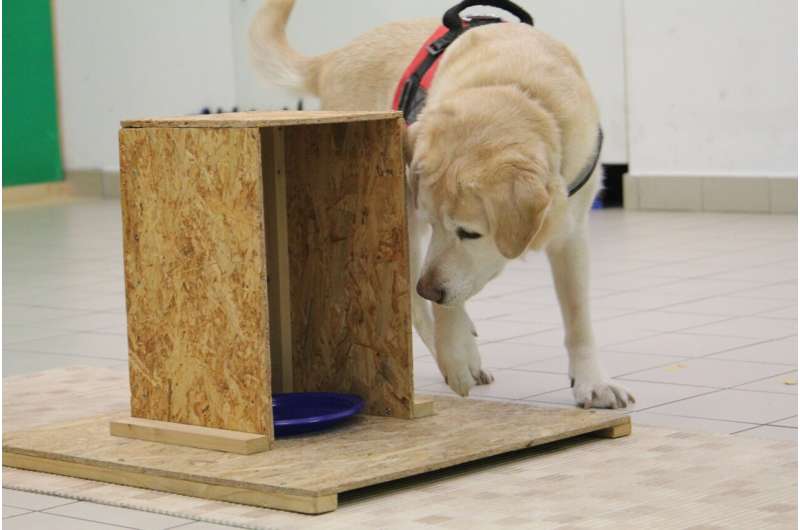This article has been reviewed according to Science X's editorial process and policies. Editors have highlighted the following attributes while ensuring the content's credibility:
fact-checked
trusted source
proofread
Dogs may provide new insights into human aging and cognition

The quest to understand intelligence and unravel the workings of the mind has always been considered the holy grail of natural sciences. While we're still uncovering many mysteries, animals can provide valuable insights into the origins and organization of both mind and intellect.
In their latest study, which appears in GeroScience, researchers at the Department of Ethology at Eötvös Loránd University (ELTE) have discovered that dogs may possess a key component of intelligence known as the "g factor."
Importantly, this factor shares many characteristics with its human counterpart, including its aging patterns. These findings could bring us closer to understanding how dog (and human) cognition is organized, and how cognitive decline progresses with age.
In humans, success in various cognitive tests tends to correlate positively; for example, individuals who excel in math may also ace their literature essay. Human cognitive abilities are thus somewhat centralized, but also organized hierarchically, from specific task performances to broader cognitive domains.
At the apex of this hierarchy lies the so-called general cognitive factor, or the g factor. This g factor is a fundamental component of intelligence; it encompasses and influences all underlying cognitive abilities, and is also closely related to academic, workplace, and career success.
In their research, the Department of Ethology at ELTE researchers inquired about the existence of such a general cognitive factor in the case of dogs.
"The cognitive and socio-cognitive performance of dogs is a highly popular topic in scientific literature, yet most studies are comparative, focusing on how well dogs perform as a species. Surprisingly, these studies have largely overlooked the individual differences in specific skills and the reasons behind them. As a result, we know very little about how dogs' cognitive abilities are structured," said Borbála Turcsán, one of the lead authors of the study.
To investigate this, researchers compiled a series of seven tasks to assess the cognitive performance of 129 family dogs aged between three and fifteen years, tracking them over two and a half years. The performances in these tests formed a hierarchical structure similar to the one seen in human cognition.
Researchers identified two broad cognitive domains: independent problem-solving, which included tests of persistence, problem-solving, and memory, and learning ability, which encompassed associative learning and one-trial learning tests.
These domains were interconnected, indicating that dogs with better problem-solving skills generally learned new tasks more quickly, confirming the existence of a higher-order, general cognitive factor that ties them together. Drawing from human literature, the authors referred to this as the "canine g factor."
The researchers were not satisfied with just finding the canine g factor; they also wanted to confirm whether it had a predictive power similar to that described for g in humans.
"To confirm that we have indeed identified the general cognitive factor, we examined whether this factor correlates with individual characteristics known from the literature of humans and other animal species to be associated with the g factor," explained Tamás Faragó, a researcher at the ELTE Department of Ethology.
The results revealed that dogs with high g factor scores were more inclined to explore unfamiliar environments, showed greater interest in novelties, and performed better in new learning situations than dogs with lower scores. Moreover, the dogs' g scores were also related to their personalities, which were measured using a questionnaire filled out by the dog owners.
A high g factor score was associated with higher levels of activity, training level, and trainability. These findings confirmed that the canine g factor resembles the human g factor not only in the structure but also in external correlations.
In addition to the numerous parallels between canine and human g factors, exploring the correlations of canine cognitive abilities has opened new perspectives in the field of aging research.
"It is well-known that as dogs age, their attention, learning ability, and memory naturally decline. However, if cognitive abilities are interconnected, it's plausible that their decline with age is not independent but rather linked to a common underlying factor behind the deterioration of various abilities," emphasized Zsófia Bognár, Ph.D. student, the other lead author of the study.
The researchers also tracked the changes in the dogs' cognitive performance over two and a half years, and based on this longitudinal assessment, they demonstrated that indeed, there is a global cognitive decline; the canine g factor score decreased with age.
However, this decline was influenced by the health status of the dogs; dogs in poorer health exhibited a faster decline in the g factor value with age, whereas no significant change with age was observed in dogs in good health. While this global decline affected all cognitive abilities, the results also revealed that age-related changes in memory and associative learning abilities are influenced by other factors, leading to diverse aging dynamics.
This aging pattern resembles human aging, and it is an important finding for later efforts to identify the molecular and neurological causes of cognitive decline.
"This new research highlights intriguing parallels between human and canine aging, further strengthening the argument that dogs serve as an excellent model species for aging research," emphasized Enikő Kubinyi, leader of the MTA-ELTE Companion Animal Research Group and the Senior Family Dog Program. "Moreover, our findings support the existence of the canine g factor, suggesting that dogs can also help in understanding the evolution and background of human intelligence."
More information: Zsófia Bognár et al, Age-related effects on a hierarchical structure of canine cognition, GeroScience (2024). DOI: 10.1007/s11357-024-01123-1





















